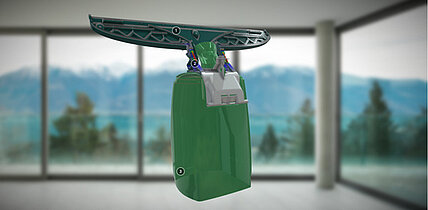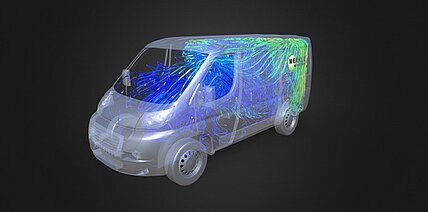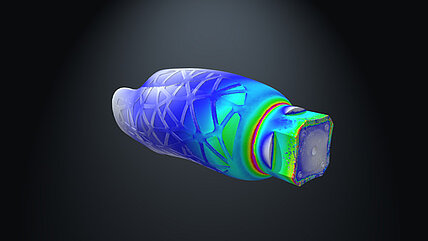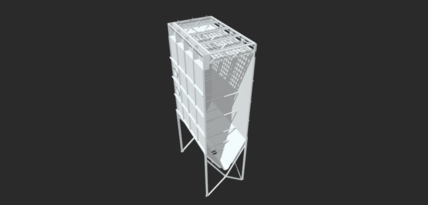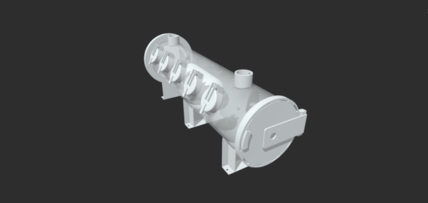FLOW IN THE CITY OF HEIDENHEIM
CFD for building planning
Wind flow conditions in cities are increasingly of great interest for construction measures. Whether it is a new building or the imminent demolition of an existing building or an entire area, the wind conditions in the surrounding area are significantly affected. Flow simulations using CFD can be used to find out how.
It is often individual buildings or entire building complexes where the wind conditions are of great interest.
Whether it is large shopping malls, covered shopping arcades or entire train stations, CFD (Computational Fluid Dynamics) flow simulations can be used to determine whether passers-by will be disturbed.
Simulation technologies for wind load calculation
CFD and FEM simulations for building and urban planning
Storms are and have always been one of the weather phenomena of our time. They can be caused by temperature differences, for example when warm and humid air rises and meets cooler air at higher altitudes. These temperature differences can cause air masses to increase in speed and release energy through the condensation of vapor into water. Storms become problematic for us and our forests when they become very violent. For example, the "storm of the century" Lothar, a hurricane that caused major damage in parts of northern France, Switzerland and southern Germany in the winter of 1999.
Making storms and winds predictable
But it doesn't always have to be as drastic as hurricane Lothar. Even "smaller" storms can cause considerable damage. It is becoming increasingly important for the planning and construction of safe settlements to take wind and wind loads into account. In detail, buildings, traffic lights, signs, electricity pylons and cables or solar installations must be able to withstand individual and permanent wind loads. The same applies to the overall structure, such as a city, which is additionally influenced by its topographical position.
This is where engineering simulation calculations come into play. Numerical simulation methods - FEM (finite element method) and CFD (computational fluid dynamics) - are used to investigate the behavior of structures and fluids under different conditions. Both methods could also be used to simulate the behavior of trees under wind load.
FEM - structures and geometries as a basis
FEM can be used to model the mechanical behavior via the geometry of bodies and their loads. This means that the behavior of a tree, a building or an electricity pylon can be digitally modeled under wind load in order to make predictions about the behavior and, if necessary, the failure of the structures. Simulation technologies are so advanced that the predictions are almost identical to actual tests in reality. The technologies are used to predict fracture behaviour or wear and to positively influence and optimize the behaviour of products while they are still being designed.
CFD - Calculating flows and pressures
On the other hand, CFD calculations are used to simulate flows and pressures, such as the wind pressure on the surface of a tree or building, in order to calculate the aerodynamic forces. In the case of a tree, this can help to investigate the influence of changes in tree shape, for example by pruning or removing branches, on the wind load. In the case of buildings, structures and shapes can be selected so that the building is safe and stable even under high wind loads. It is often individual buildings or entire building complexes where the wind conditions are of great interest.
Learning from previous phenomena
Whether large shopping malls, covered shopping arcades or entire train stations, CFD (computational fluid dynamics) flow analyses can be used to determine whether there will be any disruptive effects for passers-by.
Storms of the century such as Lothar are tragic events that cause more than just material damage. These events should be used to learn from them, to be prepared and to ensure greater safety. For example, when Lothar devastated the Black Forest, the first row of trees, which were directly exposed to the wind, often suffered no damage, while the back rows were completely uprooted. This is because the trees at the edge of the forest are more exposed to the wind and have therefore been strengthened by the wind over the years. Through this process, they have developed a more stable root system and a stronger wood structure to withstand the winds. In contrast, the trees in the interior of the forest are often surrounded and protected by other trees, making them less exposed to the wind. These trees may therefore not have as much resistance to strong winds and are therefore more likely to be uprooted.
Another factor that can play a role is the soil. Trees growing on loose or moist soils often have shallower root systems than trees on firm soil.
Overall, the likelihood of trees uprooting in a century storm depends on many factors, including location in the forest, soil conditions and the type of tree. However, the flow conditions and terrain also play a role that should not be neglected. Rollers and vortices can form, leading to high wind speeds even within the forest.
Be prepared for the future with data from simulations
All of these factors are also important for building and urban planning - in a modified form, of course. Here, simulation technologies such as FEM and CFD not only help to keep safety high, for example in the construction of high-rise buildings, but also the quality of life factor: how do building structures affect currents, for example when it comes to ensuring little wind turbulence and "draught" in pedestrian zones, parks or open spaces with restaurants. All of this can be predicted and built in a targeted manner in the real world following the digital simulation.
BIM – Building Information Modelling
In modern building design, the data is already captured in 3D using BIM (Building Information Modeling). Merkle CAE Solutions can process this three-dimensional CAD data directly in order to simulate the flow conditions in the building's interior or exterior. In this 3D example, a quick elevation of the town of Heidenheim in the area of the Schlossberg was created using data from Google Earth. The shape of the terrain was roughly modeled by hand using the contour lines.
However, it is also possible to go into much more detail in the description of the buildings. The shape and height of buildings in large cities are also available via Google Street View and can be processed further. If you need a more detailed description of existing buildings and no CAD data is available, 3D scans can be created and processed.
Significantly detailed models of entire cities can be easily calculated on the Merkle CAE Solutions clusters. If corresponding terrain profiles are available, the flooding behavior during heavy rainfall can also be simulated with CFD.
